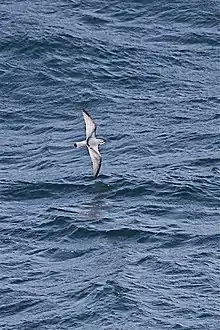Pachyptila
Pachyptila is a genus of seabirds in the family Procellariidae and the order Procellariiformes. The members of this genus and the blue petrel form a sub-group called prions. They range throughout the southern hemisphere, often in the much cooler higher latitudes. Three species, the Broad-billed Prion (Pachyptila vittata), the Antarctic Prion (Pachyptila desolata) and the Fairy Prion (Pachyptila turtur), range into the subtropics.
| Pachyptila | |
|---|---|
 | |
| Slender-billed prion | |
| Scientific classification | |
| Kingdom: | Animalia |
| Phylum: | Chordata |
| Class: | Aves |
| Order: | Procellariiformes |
| Family: | Procellariidae |
| Genus: | Pachyptila Illiger, 1811 |
| Species | |
| |
Etymology
The name Pachyptila derives from the Greek words παχύς (pachýs, "thick" or "stout") and πτίλον (ptílon, "feather"). Also from the Greek language, prion comes from the word πριόνι (prióni, "saw"), in reference to the serrated edges of its bill.[1]
Taxonomy
All the members of this genus, along with the rest of the Procellariiformes, share certain identifying features. First, they have nasal passages that attach to the upper bill called naricorns, although the nostrils on the albatross are on the sides of the bill. The bills of Procellariiformes are also unique in that they are split into between seven and nine horny plates. The genus produces a stomach oil made up of wax esters and triglycerides that is stored in the proventriculus. This can be sprayed out of their mouths as a defence against predators and as an energy-rich food source for chicks and for the adults during their long flights.[2] Finally, they also have a salt gland that is situated above the nasal passage and helps free their bodies of the salt in the seawater they often imbibe. The gland excretes a concentrated saline solution from the nose.[3]
Species
- Pachyptila turtur, fairy prion, breeds on subtropical and subantarctic islands[4]
- Pachyptila belcheri, slender-billed prion, breeds on Crozet Islands, Kerguelen Islands, Falkland Islands, and Noir Island[4]
- Pachyptila crassirostris, fulmar prion
- Pachyptila crassirostris crassirostris, breeds on Snares Islands, Bounty Island, and Chatham Islands[4]
- Pachyptila crassirostris eatoni, breeds on Heard Island and the Auckland Islands[4]
- Pachyptila vittata, broad-billed prion, breeds on islands near New Zealand and the Tristan da Cunha group[4]
- Pachyptila desolata, Antarctic prion
- Pachyptila desolata desolata, breeds Crozet Islands, Kerguelen Islands, and Macquarie Island[4]
- Pachyptila desolata altera, breeds on Heard Island and Auckland Island[4]
- Pachyptila desolata banksi, breeds on the Scotia Archipelago, South Georgia, South Sandwich Islands, and Scott Island[4]
- Pachyptila salvini, Salvin's prion
- Pachyptila salvini salvini, breeds on Prince Edwards Islands and Crozet Islands[4]
- Pachyptila salvini macgillivrayi, breeds on Amsterdam Island and St. Paul Island[4]
Behaviour
The members of this genus primarily eat zooplankton by filtering water through their upper bill. Some even hydroplane, a technique where they filter food out the water while flying with their bill in the ocean. They breed colonially, and do so near the ocean, usually with the same mate for life. Both sexes help incubate the egg, and care for the chick.[5]
Range and habitat
They are pelagic and seldom come to land, except to breed. Also, they all stay in the Southern Hemisphere, and breed on subantarctic islands except the fairy prion which breeds on subtropical islands.[4]
Footnotes
- Gotch, A. T. (1995)
- Double, M. C. (2003)
- Ehrlich, Paul R. (1988)
- Clements, James (2007)
- Maynard, B. J. (2003)
References
- Brands, Sheila (14 Aug 2008). "Systema Naturae 2000 / Classification - Genus Pachyptila". Project: The Taxonomicon. Archived from the original on October 1, 2010. Retrieved 22 July 2009.
- Clements, James (2007). The Clements Checklist of the Birds of the World (6 ed.). Ithaca, NY: Cornell University Press. ISBN 978-0-8014-4501-9.
- Double, M. C. (2003). "Procellariiformes (Tubenosed Seabirds)". In Hutchins, Michael; Jackson, Jerome A.; Bock, Walter J.; Olendorf, Donna (eds.). Grzimek's Animal Life Encyclopedia. 8 Birds I Tinamous and Ratites to Hoatzins. Joseph E. Trumpey, Chief Scientific Illustrator (2nd ed.). Farmington Hills, MI: Gale Group. pp. 107–111. ISBN 0-7876-5784-0.
- Ehrlich, Paul R.; Dobkin, David, S.; Wheye, Darryl (1988). The Birders Handbook (First ed.). New York, NY: Simon & Schuster. pp. 29–31. ISBN 0-671-65989-8.
- Gotch, A. F. (1995) [1979]. "Albatrosses, Fulmars, Shearwaters, and Petrels". Latin Names Explained A Guide to the Scientific Classifications of Reptiles, Birds & Mammals. New York, NY: Facts on File. p. 192. ISBN 0-8160-3377-3.
- Maynard, B. J. (2003). "Shearwaters, petrels, and fulmars (Procellariidae)". In Hutchins, Michael; Jackson, Jerome A.; Bock, Walter J.; Olendorf, Donna (eds.). Grzimek's Animal Life Encyclopedia. 8 Birds I Tinamous and Ratites to Hoatzins. Joseph E. Trumpey, Chief Scientific Illustrator (2nd ed.). Farmington Hills, MI: Gale Group. pp. 123–133. ISBN 0-7876-5784-0.